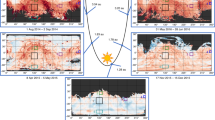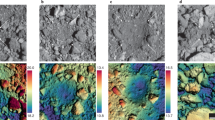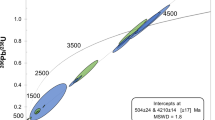Abstract
Pits have been observed on many cometary nuclei mapped by spacecraft1,2,3,4. It has been argued that cometary pits are a signature of endogenic activity, rather than impact craters such as those on planetary and asteroid surfaces. Impact experiments5,6 and models7,8 cannot reproduce the shapes of most of the observed cometary pits, and the predicted collision rates imply that few of the pits are related to impacts8,9. Alternative mechanisms like explosive activity10 have been suggested, but the driving process remains unknown. Here we report that pits on comet 67P/Churyumov–Gerasimenko are active, and probably created by a sinkhole process, possibly accompanied by outbursts. We argue that after formation, pits expand slowly in diameter, owing to sublimation-driven retreat of the walls. Therefore, pits characterize how eroded the surface is: a fresh cometary surface will have a ragged structure with many pits, while an evolved surface will look smoother. The size and spatial distribution of pits imply that large heterogeneities exist in the physical, structural or compositional properties of the first few hundred metres below the current nucleus surface.
This is a preview of subscription content, access via your institution
Access options
Subscribe to this journal
Receive 51 print issues and online access
$199.00 per year
only $3.90 per issue
Buy this article
- Purchase on Springer Link
- Instant access to full article PDF
Prices may be subject to local taxes which are calculated during checkout




Similar content being viewed by others
Change history
02 July 2015
The values in the second column of Extended Data Table 2 were corrected.
References
Keller, H. U., Kramm, R. & Thomas, N. Surface features on the nucleus of comet Halley. Nature 331, 227–231 (1988)
Soderblom, L. A. et al. Observations of comet 19P/Borrelly by the miniature integrated camera and spectrometer aboard Deep Space 1. Science 296, 1087–1091 (2002)
Brownlee, D. E. et al. Surface of young Jupiter family comet 81P/Wild 2: view from the Stardust spacecraft. Science 304, 1764–1769 (2004)
Thomas, P. C. et al. The nucleus of comet 9P/Tempel 1: shape and geology from two flybys. Icarus 222, 453–466 (2013)
A'Hearn, M. F. et al. Deep Impact: excavating comet Tempel 1. Science 310, 258–264 (2005)
Schultz, P., Hermalyn, B. & Veverka, J. The Deep Impact crater on 9P/Tempel-1 from Stardust-NExT. Icarus 222, 502–515 (2013)
Holsapple, K. A. & Housen, K. R. A crater and its ejecta: an interpretation of Deep Impact. Icarus 187, 345–356 (2007)
Vincent, J.-B., Oklay, N., Marchi, S., Höfner, S. & Sierks, H. Craters on comets. Planet. Space Sci. 107, 53–63 (2015)
Belton, M. J. S. et al. The origin of pits on 9P/Tempel 1 and the geologic signature of outbursts in Stardust-NExT images. Icarus 222, 477–486 (2013)
Belton, M. J. S. et al. Cometary cryo-volcanism: source regions and a model for the UT 2005 June 14 and other mini-outbursts on comet 9P/Tempel 1. Icarus 198, 189–207 (2008)
Keller, H. U. et al. OSIRIS – The scientific camera system onboard Rosetta. Space Sci. Rev. 128, 433–506 (2007)
Sierks, H. et al. On the nucleus structure and activity of comet 67P/Churyumov-Gerasimenko. Science 347, aaa1044 (2015)
Kirk, R. et al. Topography of the 81/P Wild 2 nucleus derived from Stardust stereoimages. Lunar Planet. Sci. XXXVI, 2244 (2005)
Basilevsky, A. T. & Keller, H. U. Comet nuclei: morphology and implied processes of surface modification. Planet. Space Sci. 54, 808–829 (2006)
Farnham, T. L. et al. Dust coma morphology in the Deep Impact images of comet 9P/Tempel 1. Icarus 187, 26–40 (2007)
Feldman, P. D. et al. Hubble Space Telescope observations of comet 9P/Tempel 1 during the Deep Impact encounter. Icarus 187, 113–122 (2007)
Tubiana, C. et al. 67P/Churyumov-Gerasimenko: activity between March and June 2014 as observed from Rosetta/OSIRIS. Astron. Astrophys. 573, A62 (2015)
Waltham, T., Bell, F. G. & Culshaw, M. G. Sinkholes and Subsidence (Springer, 2007)
Thomas, N. et al. The morphological diversity of comet 67P/Churyumov-Gerasimenko. Science 347, aaa0440 (2015)
Weissman, P. R., Asphaug, E. & Lowry, S. C. in Comets II (eds Festou, M. C. et al.) 337–357 (Univ. Arizona Press, 2004)
Groussin, O. et al. The temperature, thermal inertia, roughness and color of the nuclei of comets 103P/Hartley 2 and 9P/Tempel 1. Icarus 222, 580–594 (2013)
Feaga, L. M., A’Hearn, M. F., Sunshine, J. M., Groussin, O. & Farnham, T. L. Asymmetries in the distribution of H2O and CO2 in the inner coma of comet 9P/Tempel 1 as observed by Deep Impact. Icarus 190, 345–356 (2007)
A'Hearn, M. F. et al. EPOXI at comet Hartley 2. Science 332, 1396–1400 (2011)
Prialnik, D., Benkhoff, J. & Podolak, M. in Comets II (eds Festou, M. C. et al.) 359–387 (Univ. Arizona Press, 2004)
Hillman, Y. & Prialnik, D. A quasi 3-D model of an outburst pattern that explains the behavior of comet 17P/Holmes. Icarus 221, 147–159 (2012)
Tancredi, G., Rickman, H. & Greenberg, J. M. Thermochemistry of cometary nuclei. I. The Jupiter family case. Astron. Astrophys. 286, 659–682 (1994)
Marboeuf, U. & Schmitt, B. How to link the relative abundances of gas species in coma of comets to their initial chemical composition? Icarus 242, 225–248 (2014)
Delsemme, A. H. in Comets (ed. Wilkening, L. L. ) 85–130 (Univ. Arizona Press, 1982)
Sekanina, Z. Anisotropic emission from comets: fans versus jets. I. Concept and modeling. In Proc. International Symposium on the Diversity and Similarity of Comets, Vol. ESA SP-278, 315–322 (1987)
Belton, M. J. S. Cometary activity, active areas, and a mechanism for collimated outflows on 1P, 9P, 19P, and 81P. Icarus 210, 881–897 (2010)
Crifo, J.-F., Rodionov, A. V., Szegö, K. & Fulle, M. Challenging a paradigm: do we need active and inactive areas to account for near-nuclear jet activity? Earth Moon Planets 90, 227–238 (2002)
Marsden, B. G., Sekanina, Z. & Yeomans, D. K. Comets and non-gravitational forces. V. Astron. J. 78, 211–225 (1973)
Tozzi, G. P. et al. Evolution of the dust coma in comet 67P/Churyumov-Gerasimenko before the 2009 perihelion. Astron. Astrophys. 531, A54 (2011)
Lara, L. M., Lin, Z.-Y., Rodrigo, R. & Ip, W.-H. 67P/Churyumov-Gerasimenko activity evolution during its last perihelion before the Rosetta encounter. Astron. Astrophys. 525, A36 (2011)
Snodgrass, C. et al. Beginning of activity in 67P/Churyumov-Gerasimenko and predictions for 2014–2015. Astron. Astrophys. 557, A33 (2013)
Ghormley, J. A. Enthalpy changes and heat-capacity changes in the transformations from high-surface-area amorphous ice to stable hexagonal ice. J. Chem. Phys. 48, 503–508 (1968)
De Sanctis, M. C., Lasue, J. & Capria, M. T. Seasonal effects on comet nuclei evolution: activity, internal structure, and dust mantle formation. Astron. J. 140, 1–13 (2010)
White, W. B. Geomorphology and Hydrology of Karst Terrains (Oxford Univ. Press, 1988)
Richardson, J. E. & Melosh, H. J. An examination of the Deep Impact collision site on comet Tempel 1 via Stardust-NExT: placing further constraints on cometary surface properties. Icarus 222, 492–501 (2013)
Acknowledgements
OSIRIS was built by a consortium of the Max-Planck-Institut für Sonnensystemforschung, Katlenburg-Lindau, Germany, the CISAS, University of Padova, Italy, the Laboratoire d’Astrophysique de Marseille, France, the Instituto de Astrofísica de Andalucia, CSIC, Granada, Spain, the Research and Scientific Support Department of the European Space Agency, Noordwijk, The Netherlands, the Instituto Nacional de Técnica Aeroespacial, Madrid, Spain, the Universidad Politéchnica de Madrid, Spain, the Department of Physics and Astronomy of Uppsala University, Sweden, and the Institut für Datentechnik und Kommunikationsnetze der Technischen Universität Braunschweig, Germany. The support of the national funding agencies of Germany (DLR), France (CNES), Italy (ASI), Spain (MEC), Sweden (SNSB), and the ESA Technical Directorate is acknowledged. This work was also supported by NASA JPL contract 1267923 to the University of Maryland (M.F.A’H. and D.B.). M.F.A’H. is a Gauss Professor at the Akademie der Wissenschaften zu Göttingen and Max-Planck-Institut für Sonnensystemforschung (Germany). This research has made use of NASA’s Astrophysics Data System Bibliographic Services. We thank H. J. Melosh for reviews and criticism.
Author information
Authors and Affiliations
Contributions
J.-B.V. led the study, identified the pits and measured their global parameters. D.B. analysed outbursts and phase change transitions and prepared the sinkhole model. S.B. performed the detailed morphology analysis. H.S., C.B., P.L., R.R., D.K. and H.R. are the lead scientists of the OSIRIS project. The other authors are co-investigators who built and ran this instrument and made the observations possible, and associates and assistants who participated in the study.
Corresponding author
Ethics declarations
Competing interests
The authors declare no competing financial interests.
Additional information
All data presented in this paper will be delivered to the ESA’s Planetary Science Archive and NASA’s Planetary Data System in accordance with the schedule established by the Rosetta project and will be available on request before that archiving.
Extended data figures and tables
Extended Data Figure 1 Perihelion distance of comet 67P as a function of time.
Solid line, mean value of the orbits integrated according to a Monte Carlo method. Dashed lines, standard deviation of the mean value. a, Perihelion distance over the last 270 years, when comet 67P experienced several close encounters with Jupiter. b, The long term integration over the full dynamical lifetime of the comet (10,000 years).
Extended Data Figure 2 Multiple views of the Seth_01 pit observed by the OSIRIS camera.
a, Southern part of the pit wall; b, western part of the pit wall; c, d, eastern part of the pit wall with different illumination conditions; and e, southeastern part of the pit wall observed in the shadow. In all the images, the green arrow points to the same boulder and the blue arrow to the same ridge inside the pit. The orange arrows point to terraces within the pit. The Seth_01 pit is 220 m in diameter.
Extended Data Figure 3 Multiple views of the Ma'at_01, Ma'at_02 and Ma'at_03 pits observed by the OSIRIS camera.
a, b, Side views of the pits with different illumination conditions; c, opposite viewing conditions highlighting the other side in the shadow; and d, e, detailed views of Ma’at_02 (d) and Ma’at_01 (e) from light reflection in the shadow. Note the clear cross-cutting fractures on the wall in e. In c, the white line is an artefact due to stretching of the image to highlight the shadowed part. The Ma’at_02 pit is 130 m in diameter. The blue, green and oranges arrows point to the same features in each image.
Extended Data Figure 4 Additional views of the Seth_01 and Ma'at_01 pits.
a, The floor of Seth_01 shows no accumulation of boulders; the same is true for Seth_02 and Seth_03 (not shown). b, The floor of Ma’at_01 shows a few boulders that have accumulated; note the activity located at the bottom. c, The floor of Ma’at_02 shows an asymmetric accumulation of boulders that could be the result of upper wall collapse.
Extended Data Figure 5 Boulder counts in Ma'at_01 and Ma'at_02.
We counted boulders on the floor of Ma’at_01 and Ma’at_02. We used OSIRIS narrow angle camera (NAC) images with a resolution of 1.2 metres per pixel, acquired at 67 km from the comet nucleus centre. a, b, The illumination conditions are such that almost 80% of the floor of Ma’at_01 (a) and 95% of the floor of Ma’at_02 (b) are illuminated and the pits are facing the observer, which ensures an unbiased boulder count. We identified 23 boulders inside Ma’at_01 and 68 on the floor of Ma’at_02. The diameter of the boulders (in metres) is indicated by the coloured circles; see inset. Despite the 1.2 metres per pixel resolution, we were able to identify some boulders with a diameter between 1.5 m and 2.5 m (9 in Ma'at_01 and 15 in Ma'at_02), owing to the presence of elongated shadows. The maximum boulder diameter is 4.3 m in Ma’at_01 and 9.0 m in Ma’at_02.
Extended Data Figure 6 Cumulative boulder-size distribution for Ma’at_01 and Ma’at_02.
This distribution has a power index of  for Ma’at_01 (left) and
for Ma’at_01 (left) and  for Ma’at_02 (right), for boulder diameters greater than 3 m; the corresponding power laws are indicated the by the solid (fit) lines. Boulders smaller than 3 m in diameter are at the edge of our detection limit, meaning that the counts for these boulders are less reliable than the other counts; consequently, they were not included when fitting the power law. The higher number of boulders in Ma’at_02 is consistent with the theory that boulders are debris that falls from the walls as the pit erodes, long after the initial formation of the pit. Error bars are defined as the square root of the cumulative number of boulders to reflect the increasing diameter uncertainty for small boulder sizes.
for Ma’at_02 (right), for boulder diameters greater than 3 m; the corresponding power laws are indicated the by the solid (fit) lines. Boulders smaller than 3 m in diameter are at the edge of our detection limit, meaning that the counts for these boulders are less reliable than the other counts; consequently, they were not included when fitting the power law. The higher number of boulders in Ma’at_02 is consistent with the theory that boulders are debris that falls from the walls as the pit erodes, long after the initial formation of the pit. Error bars are defined as the square root of the cumulative number of boulders to reflect the increasing diameter uncertainty for small boulder sizes.
Extended Data Figure 7 RGB view of the Seth pits and the Hapi region.
The red–blue–green components of this colour map represent colour ratios between the reflectance signals measured at different wavelengths: red, 989 nm/649 nm; green, 480 nm/649 nm; blue, 649 nm. The colour map is overlaid onto a grey image showing the comet surface. The Hapi region and part of Seth appear with a blue hue, indicative of a bluer spectral slope than other regions of the nucleus, which are typically red. The interior of Seth_01, Seth_02 and Seth_03 have the same blue hue that is characteristic of the active Hapi region.
Extended Data Figure 8 Modelled critical ceiling thickness for increasing cavity diameter and different tensile strengths.
We predict the average tensile strength of a collapsed layer using the dimensions of a pit (Methods). For example, a pit of 220 m in diameter and 185 m in depth (such as, Seth_01) suggests that the collapsed layer had an average tensile strength of 50 Pa.
Rights and permissions
About this article
Cite this article
Vincent, JB., Bodewits, D., Besse, S. et al. Large heterogeneities in comet 67P as revealed by active pits from sinkhole collapse. Nature 523, 63–66 (2015). https://doi.org/10.1038/nature14564
Received:
Accepted:
Published:
Issue Date:
DOI: https://doi.org/10.1038/nature14564
This article is cited by
-
The Comet Interceptor Mission
Space Science Reviews (2024)
-
Selected phenomena that affect the structure of the cometary landscape
Journal of Astrophysics and Astronomy (2021)
-
Cometary Nuclei—From Giotto to Rosetta
Space Science Reviews (2020)
-
Origin and Evolution of Cometary Nuclei
Space Science Reviews (2020)
-
Surface Morphology of Comets and Associated Evolutionary Processes: A Review of Rosetta’s Observations of 67P/Churyumov–Gerasimenko
Space Science Reviews (2019)
Comments
By submitting a comment you agree to abide by our Terms and Community Guidelines. If you find something abusive or that does not comply with our terms or guidelines please flag it as inappropriate.



